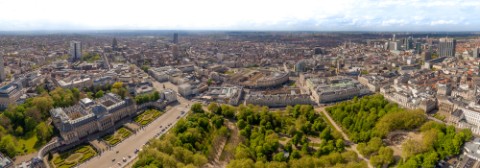When it comes to politics and administration, nothing in Belgium is ever simple! Brussels is no exception to the rule. Brussels the capital of Europe, the Brussels-Capital area, the Brussels area, the Brussels conurbation, Brussels City and simply Brussels refer to more or less the same thing...but not exactly. It isn't all that easy for the uninitiated to find their bearings, and less still to decide which area to live in. Attempt at an explanation aimed at expats.
Brussels: a region, a capital, a city and 19 municipalities
Belgium is divided into 3 regions, each with their own government (which themselves sit below the federal government): the Flemish region (Dutch-speaking), the Walloon region (French-speaking) and the Brussels-Capital region (bilingual). This last, which is commonly known as "Brussels" or the Brussels conurbation, is made up of 19 municipalities (comparable to the 'arrondissements' of Paris or districts of Berlin) which are home to around 1.2 million residents. The largest of these districts (and here's where it gets complicated!) is called Brussels, often known as Brussels City to distinguish it from the region and the conurbation. If you've got this far, don't worry: it gets easier from here on in!
Which district should you choose and why?
Each of the 19 districts has its own particular features. Greener, more upmarket, more picturesque, more downmarket, more historic, quieter, better-known... As different as they are from each other, all have their own charm. We will introduce them to you one by one.
Brussels City: the historic heart
This extremely large district (32.6 km2) practically crosses Brussels from north to south. It is made up of 6 parts: the Pentagon (historic centre, home to the Grand-Place), the Louise-Roosevelt south axis (which links the city to the Bois de la Cambre), Laeken (home to the palace where the king and his family live), the European quarter (where the European institutions are based), Neder-over-Hembeek and Haren (more industrial). The Louise and Roosevelt areas are prized for their proximity to the forest and their prestigious real estate. The city centre will primarily attract fans of entertainment and nightlife, especially around the Dansaert quarter and its luxury boutique shops.
Favourite districts for expats
Uccle
Situated to the south of Brussels on the edge of a forest, it is the next-biggest district after Brussels City but is also one of the least densely populated. Its large green areas and its villas with ornate facades are popular features.
Sought-after areas: Fort Jaco, Lycée français, Vert Chasseur, Observatoire, Prince d'Orange.
Ixelles
The favourite area of French expats, it has also become Brussels' most expensive. Its chic atmosphere of being a village within the city, its houses and its Brussels-style townhouses, its lively parks and squares and its many trendy bars and restaurants make it the capital's "place to be".
Sought-after areas: Brugmann, Molière, Châtelain, Etangs, Abbaye de la Cambre and, for students, the university area (ULB).
Saint-Gilles
Brussels' new darling. As Ixelles' neighbour and sharing many of its qualities (architecture, parks, lively squares, fashionable restaurants and bars), it has the advantage of being less expensive (albeit not for much longer!). Its main advantage? This little district is close to everything: city centre, Louise quarter (luxury shopping), the gare du Midi station (Thalys)...
Sought-after areas: the Stéphanie-Ma Campagne-Barrière triangle (also known as "haut de Saint-Gilles").
Forest
Brussels' highest district (100 m), it also borders Ixelles and Saint-Gilles. Less lively, it is nonetheless popular thanks to its large parks and its charming houses in the traditional Brussels' style.
Sought-after areas: Forest and Duden parks, Altitude 100, Molière-Longchamps.
Watermael-Boitsfort
Situated to the south of Brussels, it is one of the city's most charming and green districts. Surrounded by the Sonian forest and the Bois de la Cambre, it is overflowing with renovated historic workers' housing and beautiful villas. It is close both to the university and the southern edge, very upmarket.
Sought-after areas: pretty much all of them!
Woluwe-Saint-Pierre and Woluwe-Saint-Lambert
These two districts to the east of Brussels, which are essentially residential, are prized for their beautiful villas and their peace and quiet. Woluwe-Saint-Pierre is home to some of the capital's most expensive properties and a very beautiful (and large) park punctuated with small lakes, which attracts many walkers and joggers.
Sought-after areas: all the areas along Woluwe park and the Avenue de Tervuren.
Auderghem
Situated in south-east Brussels, this district's mixture of very green areas and a more lively central shopping area makes it comparable to Uccle. Its proximity to both the Sonian forest and the European institutions is an advantage that expats appreciate.
Sought-after areas: Beaulieu, Rouge-Cloître, Souverain-Val Duchesse.
Etterbeek
This quiet little district, essentially residential and fairly densely populated, has many buildings in the traditional Brussels' style dating back to the start of the 20th century. However, it is its direct proximity to the European institutions which interests expats above all.
Sought-after areas: around the Cinquantenaire.
The less well-known districts
Schaerbeek
A densely populated area, Schaerbeek appears multi-cultural, with both higher-end and more downmarket areas. At its centre, Josaphat park is the real beating heart of the district. There you can find superb townhouses and very beautiful homes.
Up-and-coming areas: Square Vergote, Place des Chasseurs Ardennais, Place de Jamblinne de Meux, Place Bremer, Demolder-Riga
Anderlecht
This vast and very green district, the name of which is famous worldwide thanks to its football team, is attracting more and more people thanks to its still-affordable property. A mixture of working class and more residential areas, it is currently seeing a great flurry of real estate activity along the canal which runs through it.
Up-and-coming areas: Neerpede (around the golf course, the only 18-hole course in Brussels), Scherdemael, Astrid.
Evere
Located in north-east Brussels, this little district with the feel of a workers' town is often forgotten due to its less central location, except by those who work close by at NATO. There you can find pretty little houses and numerous shopping centres. Prices are still affordable and the district is putting a lot of effort into increasing its appeal.
Up-and-coming areas: the little workers' houses in the north of the district (between the Chaussée de Haecht and Dooglegt park).
The trio of Berchem-Saint-Agathe/Ganshoren/Koekelberg
These three districts in the north-west of Brussels, which are essentially residential, have seen a surge of interest due to their real estate market which is still highly affordable and offers some lovely surprises in less well-known and yet very green areas. There you can find pretty little houses and modern apartments, as well as some townhouses which are worth a detour, notably around Koekelberg basilica (partly in Ganshoren district).
Up-and-coming areas: Marais, Château Rivieren, Zavelenberg, Basilique.
Jette
A small district in the north of Brussels, the majority of its neighbourhoods are modern and made up of apartments built in the '50s and later. Despite this, you can find pretty detached houses built in the '20s and '30s. The shopping area, primarily around the Place de Miroir, is lively and becoming increasingly fashionable.
Up-and-coming areas: the little streets around the Boulevard De Smet-De Nayer
Molenbeek-Saint-Jean
This district to the west of Brussels does not deserve its negative reputation in the media. Even if there is clear poverty in some areas, its population lives harmoniously and it has green areas where you can still find beautiful houses at an affordable price.
Up-and-coming areas: the villas in Scheutbos park, Albert park, Karreveld.
Saint-Josse-ten-Noode
At barely 1 km2, it is the smallest of Brussels' 19 districts, but also the most densely populated and the poorest. Inexpensive, it is often the first point of arrival for immigrants seeking somewhere better.


